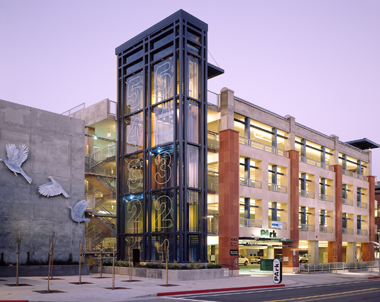
Editor’s note: This story was originally printed Monday, Aug. 13, and has been updated to include actions at that the council meeting that evening.
BY ELAINE GOODMAN
Daily Post Correspondent
The city of Palo Alto is moving forward with a federally funded traffic reduction project that includes charging a fee to workers who drive alone to their jobs and using the funds to pay a “rebate” to employees who use transit or other alternative commute methods.
The city is receiving $1.085 million from the Federal Transit Administration for the demonstration project, which is called the Bay Area Fair Value Commuting demonstration project.
The City Council will vote tonight (Aug. 13) on awarding a $225,000 contract to nonprofit Prospect Silicon Valley to serve as “principal investigator” for the project. (This contract was approved at the Aug. 13 meeting.) Contracts for three other vendors associated with the project are expected to come to the council later this month.
In a separate transportation-related item at tonight’s meeting, the council will consider more than doubling the the traffic impact fee for new development. (This item was deferred to a date to be announced “in order to evaluate implications of council action on July 30, 2018, regarding changes to the cap on office/R&D development,” City Manager Jim Keene said in a memo to council on Monday. Council on July 30 extended the cap on construction of new office and R&D space to the Stanford Research Park.)
The goal of the Fair Value Commuting project is to reduce the rate that workers drive alone to their jobs to 50%, down from the current rate of about 75%.
“Palo Alto is known as a climate leader with a strong environmentally active resident base,” City Manager Jim Keene said last year in a report to the council. “But Silicon Valley loves cars; the regional single occupancy vehicle (SOV) rate is 76%.”
According to Ride Amigos, a provider of a commuter management platform and a partner in the Fair Value Commuting project, the idea is to create a “carrot-stick” program that charges daily fees for commuters who drive alone, while offering rebates to those who use bikes, public transportation, car-shares, or “other qualified alternatives.”
“Making SOV commuting cost more is an extremely effective strategy to motivate people to seek out alternatives,” Ride Amigos says on its website.
Pilot program will involve 27,000 employees
The program will be piloted with 11 employers that have more than 27,000 employees, according to Keene’s report last year regarding the grant application to FTA.
Other project goals are making it easier for workers to access alternative commute methods and filling in gaps where options are now limited. One aspect of the project is to use Enterprise Commute Trip Reduction software to automate employer commute programs, by filling up transit fare cards, for example. Fees charged to drive-alone commuters would be used to pay the ECTR vendors.
Palo Alto will work on the project in conjunction with Joint Venture Silicon Valley and about 30 other consortium members.
Higher traffic impact fees for developers
The council will consider more than doubling the traffic impact fee for new development — generating funds that could be used to help pay for projects such as bridges to separate streets from the Caltrain tracks.
The item had been on the agenda for the council’s May 7 meeting, but was postponed until this month. Tonight’s item is a public hearing expected to last about 80 minutes. (As noted above, the item was again postponed on Monday to a date to be announced.)
The proposed new fee is $8,083 per net new peak hour trip that a development project would create. The current fee, established in 2007, is $3,575 per net new peak hour trip.
The new fee is based on estimates that about 2,855 of the 50,088 evening rush-hour trips in Palo Alto in 2030 — or 5.7% — would be the result of new development.
Therefore new development should pay for about 5.7% of the city’s costs for planned transportation projects, estimated at $404.8 million, according to city consultants. The 5.7% works out to $23 million.
In addition to the citywide traffic impact fee, a separate traffic impact fee based on square footage is now charged to new development in the San Antonio and Stanford Research Park areas, and in the Charleston-Arastradero Road corridor. The proposal being considered tonight would eliminate the fees specific to the San Antonio and
Stanford Research Park areas
Calculated a different way, the traffic impact fee would work out to $12,043 per 1,000 square feet of office development, compared to the current $5,327; and $4,850 per new hotel room, compared to the current $2,145.
The hotel fees compare to $1,834 per room in Menlo Park and $2,071 in Mountain View’s North Bayshore area. For office space, Menlo Park charges a traffic impact fee of $4,630 per 1,000 square feet, and Mountain View charges $23,260 per 1,000 square feet in the North Bayshore area.
Spending the money
In addition to funding for railroad bridges, the traffic impact fees might help pay for improvements at several intersections, including Embarcadero Road and El Camino Real, and San Antonio and East Charleston roads. Other projects on the list include an Alma Street enhanced bikeway, an intermodal transit center, and the Highway 101/Adobe Creek bike bridge.
The amount of traffic impact fees charged to a new development can be reduced if the property owner starts a transportation management program, which encourages workers to take transit or carpool, for example, rather than driving alone to work.
Certain types of development would be exempt from the citywide traffic impact fee, such as day care centers and affordable housing projects.
The city currently exempts from the traffic impact fee retail, personal service, or automotive service businesses that are 1,500 square feet or smaller. The council’s Finance Committee recommended that new retail development be charged the impact fee based on half of new car trips generated.



